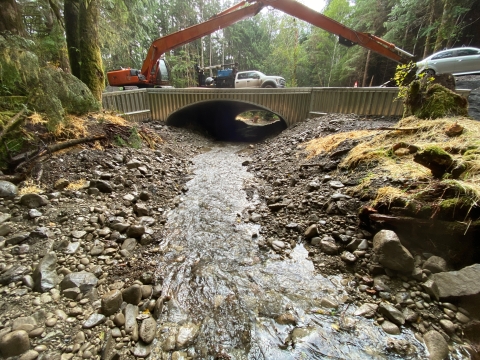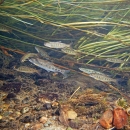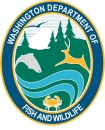States
WashingtonThis project has successfully corrected two fish passage fish passage
Fish passage is the ability of fish or other aquatic species to move freely throughout their life to find food, reproduce, and complete their natural migration cycles. Millions of barriers to fish passage across the country are fragmenting habitat and leading to species declines. The U.S. Fish and Wildlife Service's National Fish Passage Program is working to reconnect watersheds to benefit both wildlife and people.
Learn more about fish passage barriers on a Clallam County-owned road within the Sol-Duc watershed on the Olympic Coast. The barriers at Anton Creek and Cedar Creek, located at mileposts 1.74 and 1.78 of Bear Creek Road, previously blocked nearly 5 miles of verified anadromous habitat upstream, which includes vital beaver ponds and wetlands.
The Anton Creek crossing, previously a 67% passable round steel culvert, has now been replaced with a more effective structure that supports fish movement. Similarly, the Cedar Creek crossing, which was a 33% passable timber box culvert, has also been upgraded, ensuring it no longer obstructs aquatic species.
By addressing these obsolete and poorly designed culverts and stream crossings, the project has significantly improved fish passage, allowing species to move freely to feed, migrate, and reproduce. This restoration not only enhances fish populations but also contributes to the overall health of the rivers and their ecosystems.
Quick Facts:
| Project Status | Completed |
| Location | WA, Clallam |
| NFPP Project Funding | $992,000 |
| Restoration Techniques | Culvert Replacement |
| Accomplishments | 4.9 Stream Miles Reconnected |
| Project Partner Lead | Coast Salmon Partnership |
| Primary Species Benefited | Fall Chinook Salmon |
The National Fish Passage Program combines technical expertise with a track record of success.
Implemented primarily through the Service's Fish and Wildlife Conservation Offices, the National Fish Passage Program provides financial and technical assistance to partners across the country. Since 1999, the program has worked with over 2,000 local communities, Tribes, and private landowners to remove or bypass over 3,400 barriers to fish passage and reopen access to over 61,000 miles of upstream habitat for fish and other animals. Staff have expertise in fish migration and biology as well as financial, engineering, and planning assistance to communities, Tribes, and landowners to help them remove barriers and restore rivers for the benefit both fish and people.
Fish passage project proposals can be initiated by any individual, organization, government, or agency. However, proposals must be submitted and completed in cooperation with a Fish and Wildlife Conservation Office. (Please note that fish passage projects being used for federal or state compensatory mitigation or required by existing federal or state regulatory programs are not eligible for funding through the National Fish Passage Program.)
CONTACT A FISH PASSAGE COORDINATOR IN YOUR AREA TO GET STARTED.










